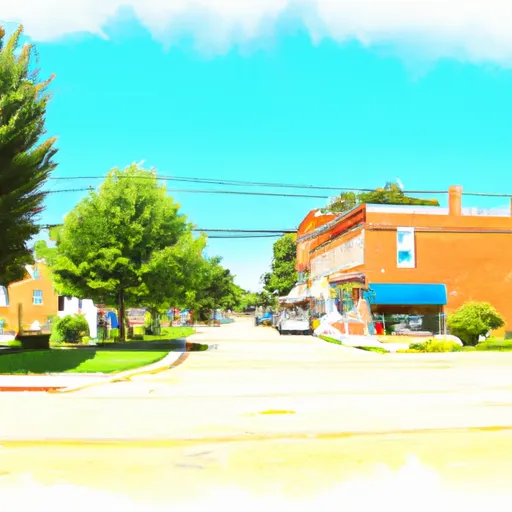-
 Snoflo Premium
Snoflo Premium
Get unlimited access to all our content
With no Ad interruptions! - Start Your Free Trial Login with existing account
Melvin
Eden Index
Climate
8.0
•
Recreation
2.5
•
Community
•
Safeguard
4.1/10

Melvin, Illinois is a small village located in Ford County, in the central part of the state. It has a population of approximately 450 residents. The climate in Melvin is classified as humid continental, with four distinct seasons. Summers are warm and humid, with temperatures ranging from the mid-70s to the mid-80s Fahrenheit. Winters are cold, with temperatures averaging in the low 30s and occasional snowfall.
Melvin is not particularly known for its hydrology constituents, as it does not have any major rivers or lakes within its vicinity. However, there are some smaller streams and ponds in the surrounding rural areas, which contribute to the local hydrology.
In terms of outdoor recreation, Melvin offers some opportunities for nature enthusiasts. The village is surrounded by picturesque countryside, providing ample opportunities for hiking, biking, and bird-watching. Additionally, there are several parks and green spaces in the area, offering facilities for picnics, sports, and playgrounds for children. Fishing is also popular in the nearby streams and ponds, attracting anglers of all skill levels.
In conclusion, Melvin, Illinois offers a pleasant climate with distinct seasons, limited hydrology constituents, and various opportunities for outdoor recreation, making it an appealing destination for nature lovers.
What is the Eden Index?
The Snoflo Eden Index serves as a comprehensive rating system for regions, evaluating their desirability through a holistic assessment of climate health, outdoor recreation opportunities, and natural disaster risk, acknowledging the profound impact of these factors on livability and well-being.
Climate Health Indicator (CHI): 8.0
Melvin receives approximately
946mm of rain per year,
with humidity levels near 84%
and air temperatures averaging around
11°C.
Melvin has a plant hardyness factor of
5, meaning
plants and agriculture in this region thrive during a short period during spring and early summer. Most
plants will die off during the colder winter months.
By considering the ideal temperature range, reliable water supplies, clean air, and stable seasonal rain or snowpacks, the Climate Health Indicator (CHI) underscores the significance of a healthy climate as the foundation for quality living.
A healthy climate is paramount for ensuring a high quality of life and livability in a region, fostering both physical well-being and environmental harmony. This can be characterized by ideal temperatures, reliable access to water supplies, clean air, and consistent seasonal rain or snowpacks.
Weather Forecast
Streamflow Conditions
Wabash
Area Rivers
Wabash
Snowpack Depths
Wabash
Reservoir Storage Capacity
Wabash
Groundwater Levels
Recreational Opportunity Index (ROI): 2.5
The Recreational Opportunity Index (ROI) recognizes the value of outdoor recreational options, such as parks, hiking trails, camping sites, and fishing spots, while acknowledging that climate plays a pivotal role in ensuring the comfort and consistency of these experiences.
Access to outdoor recreational opportunities, encompassing activities such as parks, hiking, camping, and fishing, is crucial for overall well-being, and the climate plays a pivotal role in enabling and enhancing these experiences, ensuring that individuals can engage in nature-based activities comfortably and consistently.
Camping Areas
| Campground | Campsites | Reservations | Toilets | Showers | Elevation |
|---|---|---|---|---|---|
| Natchez Trace State Park | 50 | 637 ft | |||
| Fox Ridge State Park | 45 | 728 ft | |||
| Gibson City Park | 4 | 731 ft | |||
| Sam Parr State Park | 80 | 524 ft | |||
| Rushing Creek - LBL | 56 | 402 ft | |||
| Piney - LBL | 300 | 385 ft | |||
| Prairie Pines Campground | None | 730 ft | |||
| Walnut Point State Park | 60 | 658 ft | |||
| Beech Bend | None | 373 ft | |||
| Paris Landing State Park | 63 | 392 ft |
Nearby Ski Areas
Catastrophe Safeguard Index (CSI):
The Catastrophe Safeguard Index (CSI) recognizes that natural disaster risk, encompassing floods, fires, hurricanes, and tornadoes, can drastically affect safety and the overall appeal of an area.
The level of natural disaster risk in a region significantly affects safety and the overall livability, with climate change amplifying these risks by potentially increasing the frequency and intensity of events like floods, fires, hurricanes, and tornadoes, thereby posing substantial challenges to community resilience and well-being.
Community Resilience Indicator (CRI):
The Community Resilience Indicator (CRI) recognizes that education, healthcare, and socioeconomics are crucial to the well-being of a region. The CRI acknowledges the profound impact of these elements on residents' overall quality of life. By evaluating educational resources, healthcare accessibility, and economic inclusivity, the index captures the essential aspects that contribute to a thriving community, fostering resident satisfaction, equity, and social cohesion.

